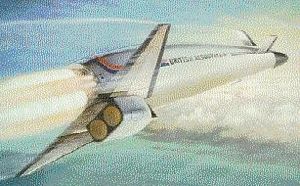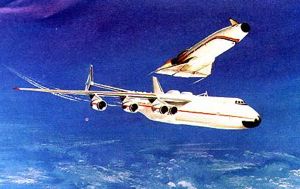
Home - Search - Browse - Alphabetic Index: 0- 1- 2- 3- 4- 5- 6- 7- 8- 9
A- B- C- D- E- F- G- H- I- J- K- L- M- N- O- P- Q- R- S- T- U- V- W- X- Y- Z
HOTOL
 HOTOL Credit: Mark Lindroos |
AKA: Horizontal Takeoff and Landing. Status: Cancelled 1985. Thrust: 3,152.20 kN (708,643 lbf). Gross mass: 250,000 kg (550,000 lb). Unfuelled mass: 50,000 kg (110,000 lb). Specific impulse: 700 s. Specific impulse sea level: 2,000 s. Burn time: 730 s. Height: 62.80 m (206.00 ft). Diameter: 7.00 m (22.90 ft). Span: 28.30 m (92.80 ft).
HOTOL development was begun in 1982 by a Rolls-Royce / British Aerospace team led by John Scott and Dr Bob Parkinson. The project was reasonably well advanced (engine detailed design and mockup) by the time the British government withdrew further funding in the mid-1980's. HOTOL would have taken off horizontally from a runway, from a purpose made, rocket propelled trolley. It would transition to pure rocket propulsion at Mach 5.0 - Mach 6.0 and ascend to orbit. A moderate re-entry profile would decrease the thermal loading constraints. HOTOL would return via a glide landing, to a landing on gear on a conventional runway.
The original HOTOL airframe design was derived from conventional vertical takeoff rockets with the engines mounted at the rear of a blunt based fuselage. Since such a vehicle's empty center of gravity was dominated by the engine location, the wings and the tank for the dense liquid oxygen also had to be at the rear. The payload bay and hydrogen tankage were placed in a projecting forebody.
The resulting configuration suffered from a severe center of pressure / center of gravity mismatch during the air breathing ascent. The center of pressure shifted 10 m forward, due to the wide Mach range, the large fuselage cross section to wing area ratio, and the long overhang of the forward fuselage. Various alterations were made to the design to handle these problems, all of which eroded the payload.
Conventional landing gear were replaced by a specially designed takeoff trolley in order to improve the marginal payload fraction. The final design had serious operational disadvantages and a small payload. The only way the designers could continue to claim to put a reasonable payload into orbit was by specifying untried and speculative structural materials.
Flyaway Unit Cost 1985$: 10.000 million.
Stage Data - HOTOL
- Stage 1. 1 x HOTOL. Gross Mass: 250,000 kg (550,000 lb). Empty Mass: 50,000 kg (110,000 lb). Thrust (vac): 1,103.200 kN (248,009 lbf). Isp: 700 sec. Burn time: 730 sec. Isp(sl): 2,000 sec. Diameter: 7.00 m (22.90 ft). Span: 28.30 m (92.80 ft). Length: 62.80 m (206.00 ft). Propellants: Liquid Air/Lox/LH2. No Engines: 3. Engine: RB545. Other designations: Horizontal Takeoff and Landing. Status: Study.
| Interim HOTOL stage LOx/LH2 propellant rocket stage. . |
| Interim HOTOL Initiated by a British Aerospace team led by Dr Bob Parkinson in 1991, this was a less ambitious, scaled-back version of the original HOTOL. The single-stage to orbit winged launch vehicle using four Russian rocket engines. It was to have been air-launched from a Ukrainian An-225 Mriya (Dream) aircraft. Interim HOTOL would separate from the carrier aircraft at subsonic speeds, and would then pull up for the ascent to orbit. It would return via a gliding re-entry and landing on gear on a conventional runway. Interim HOTOL suffered from the same aerodynamic design challenges as HOTOL and went through many, many design iterations in the quest for a practical design. |
Family: orbital launch vehicle, Winged. Country: UK. Engines: RB545. Agency: British Aerospace. Bibliography: 236, 264.
 | Hotol 2 Hotol 2 is launched from the back of an Antonov 225 Credit: British Aerospace |
 | Buran Atop Mriya Buran atop its An-225 Mriya carrier, as displayed at the Paris Air show shortly after its spaceflight. Credit: © Mark Wade |
 | Interim HOTOL 68-H version of Interim HOTOL atop the An-225 launching aircraft. Diagram produced by Fastlight. Used with permission. |
 | Interim HOTOL Test S Test empennage used to test effects of rocket exhaust from RD-0120 engine for Interim HOTOL, NIIKhimMash, March 1992. Credit: © Dietrich Haeseler |
1982 - . Launch Vehicle: HOTOL.
- HOTOL development begun by a Rolls-Royce / British Aerospace team - .
Nation: UK.
The project was reasonably well advanced (engine detailed design and mockup) by the time the British government withdrew further funding in the mid-1980's. HOTOL would have taken off horizontally, transition to pure rocket propulsion at Mach 5.0 - Mach 6.0. and ascend to orbit. A moderate re-entry profile would decrease the thermal loading constraints. HOTOL would return via a glide landing, to a landing on gear on a conventional runway.
1991 - . LV Family: HOTOL. Launch Vehicle: Interim HOTOL.
- Interim HOTOL designed by British Aerospace - . Nation: UK. This was a less ambitious, scaled-back version of the original HOTOL. The single-stage to orbit winged launch vehicle using four Russian rocket engines. It was to have been air-launched from a Ukrainian An-225 aircraft..
Back to top of page
Home - Search - Browse - Alphabetic Index: 0- 1- 2- 3- 4- 5- 6- 7- 8- 9
A- B- C- D- E- F- G- H- I- J- K- L- M- N- O- P- Q- R- S- T- U- V- W- X- Y- Z
© 1997-2019 Mark Wade - Contact
© / Conditions for Use